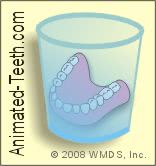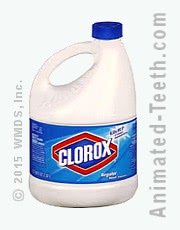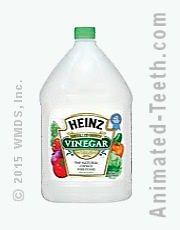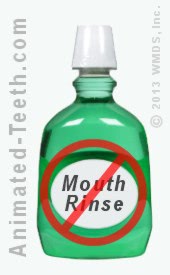Homemade denture cleaners.

Using a homemade solution can work well for denture cleaning.
You don’t have to buy a commercially-prepared soaking product for cleaning and disinfecting your false teeth. Homemade cleaners, which can be made for just a few cents using household products you already have, can be every bit as effective.
- This page provides directions for making and using bleach, vinegar, and baking soda-based denture cleaners. We also discuss the use of mouthwash as a denture soak.
- Keep in mind, chemical cleansing (soaking) is only the second half of effective denture care. Best practices always include mechanical cleansing (at minimum brushing) first.
Homemade & natural denture cleansers.
1) Bleach-based soaks.
The most commonly used homemade denture cleanser is a diluted bleach solution.
- It’s effective for both cleaning and especially disinfecting false teeth.
- It’s also effective in removing stains due to exposure to chromogenic agents such as coffee, cola, tea and tobacco products.
Issues that must be considered.
Despite its popularity, there are some concerns associated with the use of a bleach-based soak.
Especially in the case where a comparatively higher concentration solution or extended soaking period is involved, damage to your complete or partial denture may occur.
We discuss what research has reported about these issues in our “Precautions” section below.
a) Preparation and use.
There are several variations as to how a homemade bleach-based denture cleanser should be prepared and used. Based on information gathered from the studies and reports cited below, the following directions seem to be a reasonable approach for this method.
Having said that, no one is in a position to know more about your dentures and the materials that have been used to make them than your dentist. And for that reason, it’s always best to discuss your cleaning plans (of any type) with them in advance.

Denture cleaner can be made using household bleach.
Directions for making.
- A soaking mixture can be made by taking 1 part household bleach (5.25% sodium hypochlorite) and diluting it with 10 parts water. The result is roughly a 0.5% sodium hypochlorite solution.
[The sodium hypochlorite concentration found in some household bleach products is different than 5.25% (check your bottle’s label). If yours is, simply adjust your dilution accordingly. For 6% products, add an extra 2 parts of water. For 8.25% ones, use a 1 to 16 ratio.]
- It’s best to mix this soak fresh at the time of use. Doing so ensures maximum effectiveness.
If you prefer preparing a quantity of solution a few days ahead of time, it should be stored in a cool environment, in a dark location or opaque container.
Directions for using.
- Accumulated film and loose debris should be removed from your denture by way of scrubbing it with a brush first. (See link above for a discussion about this topic.)
- This soak can be used once a day for a duration of 3 to 10 minutes. Longer soaks, especially overnight, don’t make the best choice. (We discuss duration-of-use issues in detail below.)
- It’s important to thoroughly rinse your denture off with cool tap water before inserting it back into your mouth. Bleach-based solutions have the potential to irritate oral tissues.
- If your denture is not returned to your mouth, it should be stored fully immersed in water.
- [As discussed below, bleach-based solutions should not be used with dentures that have metal components, and possibly those that have certain types of relining materials.]
Why just 3 to 10 minutes daily?
- A study by de Sousa Porta evaluated the use of this soak for 3 minutes daily over the course of 90 days. It was found to be effective in reducing the numbers of microorganisms, including Candida (a common oral fungus), found on dentures.
- This recommendation stays within the guidelines of the American College of Prosthodontists (an organization of “denture specialists”). They suggest that exposure of false teeth to sodium hypochlorite solution exceeding 10 minutes should be avoided (for reasons discussed below in the “Precautions” section). (Felton)
More from the ACP’s guidelines about denture cleansers.
- The guidelines stated that, as compared to other alternative denture-immersion methods (soaking), using a bleach-based solution probably makes the most effective choice.
- They also considered bleach-based products to be the most effective type of commercial cleanser too, suggesting that, overall, using this method typically makes a best-choice.
▲ Section references – Felton, de Sousa Porta
b) How to make this homemade soak more effective.
While bleach-based denture cleaner makes a good stain remover and disinfectant, it’s not especially effective in helping to remove mineral deposits (tartar) that have built up on false teeth.
- You can give your soak added tartar-removing capability by adding one teaspoon of Calgon® water softener (Calgon the calcium-chelating agent, not Calgon the soap or bath oil) per glassful of the homemade solution above.
- After soaking, brush your denture a second time. Some mineral deposits and associated stain may still remain but have softened up enough that they can be brushed off.
c) Precautions / concerns with bleach-based denture cleaners.
[The issue of bleach-based soak safety is discussed here.]
Get your dentist’s OK.
Over the past decades, a number of studies have investigated how the plastics used in denture fabrication may be affected by different types of denture cleaners, including the homemade ones we discuss on this page.
And while what we report here does apply to standard denture materials (and therefore most people) your appliances, or the materials they have since been repaired or relined with, may be exceptions.
For this reason, the choice of any denture cleanser, homemade or commercial, should be approved by your dentist.
i) Color fading.
Bleach-based cleaners can cause the pink coloration of denture plastic to fade (the “gums” portion of your appliance). Two factors that are important with this phenomenon are the concentration of the solution that’s used, and the duration/frequency of the soaking period.
- A study by Gulfema evaluated the color changes that took place with various brands of denture acrylics (plastics) when exposed to 4 solutions, one of which was “dilute sodium hypochlorite 0.5%” (the homemade cleaner we describe above).
- After 15 days of exposure to the solution (the cumulative equivalent of almost 6 years of daily 10-minute soaks), tests showed that some color change had taken place. But the amount of change was “below the limit of visual perceptibility” (it couldn’t be detected by the human eye).
A more recent study by de Sousa Porta evaluated the use of 0.5% sodium hypochlorite solution (our mixture above) for 3 minute soaks over the course of 90 days and found no significant color changes.
These same general findings were also reported by Salles. This study simulated the use of a 0.5% solution for 20 minutes a day for 5 years and found no significant alteration of denture acrylic color.
Why soaking overnight doesn’t make the best choice.
▲ Section references – Gulfema, de Sousa Porta, Salles, Paranhos
ii) Surface roughness.
Some research suggests that the use of bleach-based soaks may tend to roughen the plastic surface of false teeth.
The concern here is that it’s been shown that an increase in surface roughness increases the ease with which microorganisms are able to adhere to denture surfaces (Verran).
- Ural evaluated the use of bleach at full-strength, 5 hours a day for 7 days. (This concentration is 10 times that of our homemade soak above. The study period was equivalent to 210 days of 10-minute soaking.)
- de Sousa Porta evaluated the use of 0.5% sodium hypochlorite solution (our mixture above) for 3 minute soaks over the course of 90 days and found no significant changes in surface roughness.
- Salles simulated the use of 0.5% solution for 20 minutes a day over a 5-year span and found no significant change in denture surface roughness.
Take note.
One study that did identify surface roughness changes is Paranhos. It simulated the use of diluted-bleach cleaner (0.5% sodium hypochlorite, our homemade dilution above) with overnight (8 hour) soaks, over the course of 180 days (almost 50 times the exposure created by the daily 10 minute treatments recommended above).
This regimen resulted in a change of surface roughness of just 0.195 microns. That number is important because Quirynen determined that changes up to 0.2 microns didn’t significantly increase the ability of microbes to adhere to denture surfaces.
▲ Section references – Verran, Ural, de Sousa Porta, Salles, Paranhos, Quirynen
iii) Denture strength.
There are studies that have suggested that the use of bleach-based soaks may affect the flexural strength of denture plastics.
In fact, the American College of Prosthodontists’ guidelines for denture cleaning that we refer to above mention this point. This seems to be their reason for suggesting that the use of bleach-based soaks should be limited to 10 minutes.
While the publication date of their blanket recommendation (no specific bleach concentration is mentioned) is fairly recent (2011), it seems to be based on a reference that reviewed related dental literature published between 1936 and 1983.
At this point in time …
A paper by Rodrigues, which included the evaluation of 0.5% sodium hypochlorite denture cleaner (our homemade mixture above), stated that
- “There is no consensus in the literature regarding how chemical cleaning agents might affect the mechanical properties of rigid reline materials and conventional thermoacrylic resin.”
(Meaning the pink plastic typically used in the construction of false teeth and the hard plastics used to reline them, as needed.)
One of the studies we refer to above, Paranhos, found no changes in the flexural strength of denture resins (plastics) when exposed to a simulated 180 days of overnight (8-hour) soakings in 0.5% sodium hypochlorite cleaner (roughly 50 times our recommended soaking time above).
The same can be said for Salles. This study simulated the use of a 0.5% solution for 20 minutes a day for 5 years and found no significant changes in denture flexural strength.
▲ Section references – Rodrigues, Salles, Paranhos, Felton
v) Metal corrosion.
! An important consideration in some cases.
Studies have shown that bleach-based soaking solutions do tend to tarnish and spot corrode metal (cobalt-chromium alloy) components of full and partial dentures (Felipucci).
The extent to which this effect will take place is likely a function of bleach concentration, soak duration and the composition of the metal involved. (The cobalt-chromium alloy mentioned above is frequently used in partial denture construction.)
▲ Section references – Felipucci
vi) Affects on denture reline materials.
! An important consideration in some cases.
The information we discuss above generally applies to false teeth made by a dental laboratory (high-quality materials, optimal fabrication process under ideal conditions).
The world of dental relines is entirely different. With relines, the process used to place them varies widely (chairside vs. laboratory), as does the type of material used (some have superior physical properties while others don’t, some set hard while others remain soft). And due to this variability, some relines hold up to certain types of cleansers better than others.
That means, at the time of your reline, it’s always best to ask your dentist if it’s compatible with the denture cleaner you currently use (homemade or not).
2) Vinegar-based soaks.
Household vinegar can be used to make a natural denture cleanser that’s effective for both disinfecting and, especially, removing tartar.
Disinfection.
- Vinegar-based soaking solutions have been shown to be effective in killing microorganisms that reside on the surface of false teeth. However, possibly less so than the homemade bleach solution described above.
- Some studies (but not all) have concluded that vinegar disinfection is the method of choice for Candida albicans (a common oral fungus).
▲ Section references – Yildirim-Bicer, Jafari
Tartar removal.
The acidic nature of vinegar makes it especially effective in removing tartar (built-up mineral deposits and associated stain). These deposits, which often have a tan to brown coloration, frequently build up in denture crevices. (These locations are frequently only accessible to chemical cleansing.)
- Smaller deposits may dissolve away entirely. Thicker buildup may only soften up but can then be brushed off.
- It may take repeated cycles of soaking and brushing to remove especially heavy deposits.
Vinegar can be used to make denture cleaner.

(Regular white vinegar, like you use in your kitchen.)
a) How to prepare and use.
- Prior to soaking, false teeth should be brushed (inside and out) to remove any soft or loose debris (see link above).
- A soaking solution can be made using white (household) vinegar. (The kind of vinegar found in most kitchens.) The following studies used the concentrations and soaking durations shown below.
a) Infrequent / periodic cleanings –
Soaking duration: 10 minutes. Vinegar concentration 100% (full-strength) to 50% (equal dilution with tap water). (Johnston, Yildirim-Bicer)
Soaking duration: 30 minutes. Vinegar concentration 50% (equal dilution with tap water). (Yadav)
b) Daily use – Soaking duration: Up to 8 hours. 10% vinegar (a 1 to 9 dilution with tap water). (Pinto)
- With infrequent or periodic cleaning, brushing your denture again after soaking may remove stubborn mineral deposits and staining that still remain but have softened up.
- When finished, thoroughly rinse your denture with cool tap water.
- If your denture is not returned to your mouth, you should store it fully immersed in water.
▲ Section references – Johnston, Yildirim-Bicer, Yadav, Pinto
b) Precautions / concerns with vinegar-based denture cleaners.
While there’s nothing new about using vinegar as a natural tartar remover and disinfectant for false teeth, it certainly seems to be less studied than other homemade alternatives. The following is all we have to report.
i) Color and strength changes.
Different than with bleach-based denture cleaners (see above), we did not encounter any studies that brought up the issue of color or flexural strength changes in denture plastics due to the use of a vinegar soak.
ii) Surface roughness.
Once again, different than with bleach soaks, we found little discussion about an increase in denture surface roughness due to the use of vinegar solution.
One study (Yildirim-Bicer) evaluated the use of both 100 and 50% vinegar solutions for the disinfection of false teeth using a 10-minute soak. And this paper did make mention of the issue of denture surface roughness. But it made no mention of problematic effects created by using these soaks.
Our reference above that evaluated the use of a 10% vinegar solution, 8 hours a day for a period of 45 days (Pinto) unfortunately did not make mention of this topic.
▲ Section references – Yildirim-Bicer, Pinto
iii) Metal corrosion.
We spent quite a bit of time researching this subject. It seems that it’s bleach-based soaks (see above) as opposed to vinegar ones that tend to tarnish the metal components of partial dentures (Nassif).
iv) Affects on denture reline materials.
! An important consideration in some cases.
As discussed above for bleach-based soaks, the materials used to reline false teeth aren’t always as durable as the plastic originally used to fabricate them. For this reason, after having a reline you should confirm your choice of denture cleaner with your dentist.
3) Consider using a multi-solution approach.
Wendt evaluated a number of soaks frequently used to disinfect dentures and came to the conclusion that the best results were obtained when a combination approach was used. The idea is that it takes using a series of solutions (each of which excels in targeting different types of microorganisms) to reach maximum cleanliness.
We’ve updated the regimen outlined in that paper, so it’s more in alignment with what today is considered best practices.
- A bleach-based solution combined with enzymatic dishwasher soap (Cascade). – Instructions given above.
- A vinegar-based soak. – Instructions given above.
- A sodium bicarbonate solution – One teaspoon of baking soda dissolved in eight ounces of water, 30-minute soak, rinse thoroughly afterward. (Use this technique instead of brushing with baking soda, here’s why.)
While it’s not expected that someone would necessarily take the time to perform this routine each day, they might choose to use it on selected ones.
▲ Section references – Wendt

There are better choices for denture cleaning than mouthwash.
4) Using mouthwash as a denture cleaner.
- Mouthwash usually has a pleasant flavor and odor.
- Some mouthwashes make antibacterial claims.
There are better choices.
Mouthwash has not been shown to be especially effective against the types of microorganisms that typically inhabit denture surfaces. This is true even for those oral rinses that make an antimicrobial claim. As an example, a study by Buergers found it ineffective in denture disinfection.
▲ Section references – Buergers
Don’t dentists use mouthwash to clean false teeth?
You may have noticed that after your dentist’s office has finished cleaning your dentures they taste like mouthwash was used.
In actuality, they’ve probably used a professional cleaner, most of which have a pretty bad taste. As a last step, they’ve had their dental staff place your false teeth in a glass of mouthwash and water (50:50), just so there’s no question that they’ll taste pleasant.
So yes, after a professional cleaning your dentures may have a mouthwash taste. But don’t confuse that issue with thinking that that’s what has been used to actually clean them.
Best practices for denture cleaning.
Due to the wide range of materials that are used in denture fabrication, you should …
a) Always discuss your plans with your dentist.
Your dentist occupies an especially unique position. Not only do they know precisely what materials have been used in making your false teeth but they get to see how they hold up to the various cleaning methods their other patients use. Make sure you tap into their knowledge.
b) Always test before you soak.
The plastics used to make false teeth are chosen, in part, because they tend not to absorb tastes and flavors. And this fact makes it unlikely that cleaning solutions that have a bad taste (i.e. bleach, vinegar) will create a problem.
But because it’s such a simple step to take, you should always perform short trial soaks with any new cleanser, just to make sure. This is especially true for appliances that have been relined.
c) General rules.
- Don’t expose your dentures to elevated temperatures. Doing so may cause dimensional distortion, thus affecting their fit. Soaking and rinsing should be done in room temperature solutions.
- Always keep your dentures wet. That means in your mouth or fully immersed in their soaking solution or just plain water. If they dry out, their fit may change. (Related content: Maximum temperatures for denture plastics.)

Our affiliate links can be used to shop for denture products on Amazon.com
Disclosure: Sales stemming from our affiliate links earn a commission for our website, although without any additional cost to you.
Page references sources:
Buergers R, et al. Efficacy of denture disinfection methods in controlling Candida albicans colonization in vitro.
de Sousa Porta SR, et al. Evaluation of sodium hypochlorite as a denture cleanser: a clinical study.
Felipucci D, et al. Effect of Different Cleansers on the Surface of Removable Partial Dentures.
Felton D, et al. Evidence-based guidelines for the care and maintenance of complete dentures.
Gulfema E, et al. Colour stability of denture base materials after soaked in different aging solutions.
Jafari AA, et al. Vinegar as a Removing Agent of Candida albicans From Acrylic Resin Plates.
Johnston C, et al. Vinegar: Medicinal Uses and Antiglycemic Effect.
Nassif J. Instructions for patients — a positive factor in removable partial denture service.
Paranhos H, et al. Color Stability, Surface Roughness and Flexural Strength of an Acrylic Resin Submitted to Simulated Overnight Immersion in Denture Cleansers.
Pinto T, et al. Vinegar as an Antimicrobial Agent for Control of Candida in Complete Denture Wearers.
Quirynen M, et al. The influence of surface free energy and surface roughness on early plaque formation. An in vivo study in man.
Rodrigues S, et al. Effect of chemical cleaning agents on the flexural strength of acrylic and hard denture line resins.
Salles MM, et al. Antimicrobial activity of complete denture cleanser solutions based on sodium hypochlorite and Ricinus communis – a randomized clinical study.
Ural C. Effect of Different Denture Cleansers on Surface Roughness of Denture Base Materials.
Verran J, et al. The effect of dentifrice abrasion on denture topography and the subsequent retention of microorganisms on abraded surfaces.
Wendt S, et al. Decontamination of Candida albicans infected denture material.
Yadav R, et al. Effectiveness of different denture cleansing methods on removal of biofilms formed in vivo.
Yildirim-Bicer AZ, et al. In vitro antifungal evaluation of seven different disinfectants on acrylic resins.
All reference sources for topic Complete and Partial Dentures.